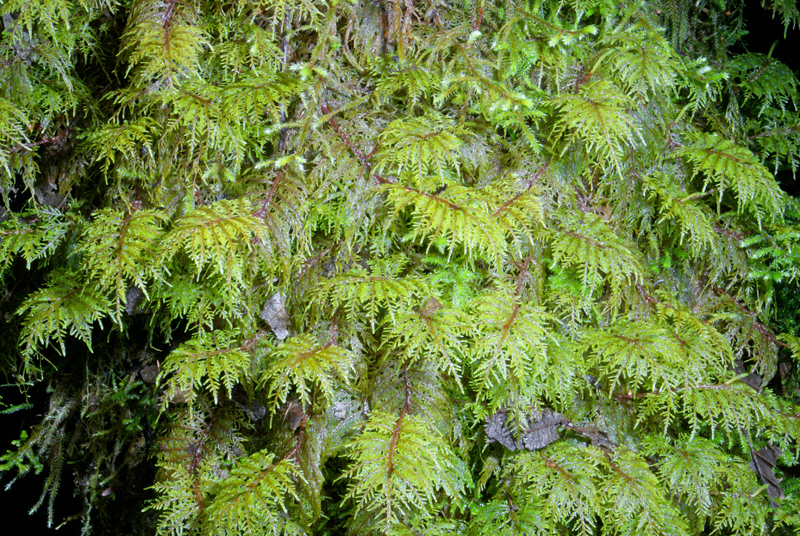![University of California [UC]](http://ucjeps.berkeley.edu/common/images/logo_uc_80.png)
![University of California [UC]](http://ucjeps.berkeley.edu/common/images/logo_uc_80.png) |
|||||
| University of California, Berkeley | |||||
| Directory News Site Map Home | |||||
California Moss eFlora
|
Jan 1 2013 ·
Home ·
List of Genera ·
Key to Keys ·
Accepted Names ·
Synonyms ·
For Beginners ·
Subdivisions of CA ·
Jepson eFlora for CA Vascular Plants |

Hylocomium splendens may produce more total biomass than any other moss in the world. It is found throughout arctic and cool temperate regions of Eurasia and North America, and it even shows discontinuities in some similar parts of the Southern Hemisphere. Despite all this abundance, and despite its great abundance even in nearby areas of Oregon and Washington, Hylocomium splendens has been found in only three sites in extreme northern parts of California. It is an immediately recognizable moss that produces repeatedly pinnately branched with strong heterophylly between the lanceolate leaves of the main upwardly arching stem and the concave and ovate to almost orbicular tiny leaves of all other orders of branching. It is commonly called the stair-step moss because of the pattern of new pinnate fronds of each year arising from central portions of the main stem of the previous year's growth.
Key to Hylocomium Etc.
The plants included in this section are plumosely branched mosses mostly with the main axes decumbent to almost erect. Pinnately branched mosses with strictly prostrate main axes are treated under Hypnum. The mosses in this section are broadly called "feather mosses," and nearly all the low elevation feather mosses of California are restricted to the extreme northern portions of the state. We note that such mosses either appear as large mats on the soil or litter, or they are completely missing. We speculate that a critical size is required for the clones of these mosses — a size that allows retention of sufficient moisture for survival through dry periods.
Species included are in Hylocomiaceae, except Helodium (Helodiaceae), Kindbergia and Trachybryum (Brachytheciaceae), Ptilium (Hypnaceae), Rhytidium (Rhytidiaceae) and Thuidium (Thuidiaceae):
Helodium blandowii (Weber & D. Mohr) Warnstorf
Hylocomium splendens (Hedwig) Bruch & W. P. Schimper
Kindbergia oregana (Sullivant) Ochyra
Kindbergia praelonga (Hedwig) Ochyra
Pleurozium schreberi (Bridel) Mitten, not known from CA
Ptilium crista-castrensis (Hedwig) De Notaris, not known from CA
Rhytidiadelphus loreus (Hedwig) Warnstorf
Rhytidiadelphus squarrosus (Hedwig) Warnstorf
Rhytidiadelphus subpinnatus (Lindberg) T. Koponen, not known from CA
Rhytidiadelphus triquetrus (Hedwig) Warnstorf
Rhytidiopsis robusta (W. J. Hooker) Brotherus
Rhytidium rugosum (Hedwig) Kindberg, not known from CA
Thuidium recognitum (Hedwig) Lindberg, not known from CA
Trachybryum megaptilum (Sullivant) W. B. Schofield
A. Costa single and extending considerably above mid-leaf .....B
A. Costae double, ending at or below mid-leaf, sometimes almost absent .....G
B. Paraphyllia present, abundant on larger stems .....C
B. Paraphyllia absent .....D
C. Leaves plicate or wrinkled; paraphyllia attached to leaf bases and to stems, lobed with the lobes narrowly lanceolate to linear; plant of bogs or fens .....Helodium: H. blandowii
C. Leaves not plicate; paraphyllia not attached to leaf bases but rather on stem, lobed into uniseriate filaments with the ultimate cell coronate-papillose; plants of mesic sites .....Thuidium: T. recognitum not known from CA
D. Leaves strongly heterophyllous with stem leaves relatively broader and more decurrent, markedly larger than branch leaves; stem leaves strongly spreading to almost squarrose .....E
D. Leaves not so heterophyllous; stem leaves, if spreading, similar in orientation to branch leaves .....F
E. Plant regularly plumose with a single main stem from which arises shorter, nearly unbranched, lateral stems; plant mainly of coastal moderately low elevation sites .....Kindbergia: K. oregana
E. Plant irregularly branched or tri- to tetra-pinnate; plant mainly of higher elevation, or of deeply shaded sites .....Kindbergia: K. praelonga
F. Leaves strongly rugose .....Rhytidium: R. rugosum not known from CA
F. Leaves closely many times plicate .....Trachybryum: T. megaptilum
G. Branched paraphyllia present and densely arranged on stems and branches .....H
G. Paraphyllia absent .....I
H. Plant regularly many times pinnately branched with the branches arranged in a single plane; leaves of ultimate branches broadly ovate, mostly less than 1 mm long .....Hylocomium splendens
H. Plant sparingly and irregularly branched with the leaves of the branches not significantly smaller than those of the stems, mostly about 4 mm long .....Rhytidiopsis: R. robusta
I. Leaves bluntly rounded at apex, never plicate or squarrose .....Pleurozium: P. schreberi not known from CA
I. Leaves acute to acuminate at apex, often plicate or squarrose .....J
J. Leaves falcate-secund, ascending or weakly spreading, plicate, not at all papillose or prorate; tips of main stems arched downward toward the substratum .....Rhytidiadelphus: R. loreus
J. Leaves not falcate, squarrose or broadly spreading, if plicate, the cells sharply prorate above mid-leaf; tips of main stems of well developed plants mostly ascending .....K
K. Leaves strongly plicate; cells sharply prorate at least above mid-leaf .....Rhytidiadelphus: R. triquetrus
K. Leaves not plicate; cells smooth .....L
L. Plant of lawns and other anthropogenic sites, pinnate but with the branches rather distantly spaced .....Rhytidiadelphus: R. squarrosus
L. Plant of natural bogs, carrs, and other wet places; branching inserted regularly in the axils of every third or fourth leaf on each side of stem .....Rhytidiadelphus: R. subpinnatus not known from CA